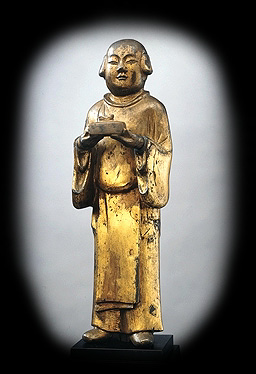

![]()
Shotoku
Male Figure, possibly Prince Shotoku
Kamakura period, early 14th century
Gilt bronzeThough this charming figure has not been identified, the court robes and looped braids suggest that he is Prince Regent Shotoku. His size suggests that he was placed in a family temple for private worship.
Among the most important figures in Japanese history, Prince Shotoku (r. 593-622) adopted Chinese and Korean policies and doctrines for Japan, and instigated major cultural, religious, economic, and political reforms. He introduced Buddhism, a foreign religion that successfully coexisted with native Shinto beliefs. He Japanized foreign systems and beliefs, in the process clarifying a notion of Japaneseness. For this, Shotoku was venerated as a national hero during his lifetime, and deified after his death. The cult of Shotoku resulted in the proliferation of his images, which were placed in temples as well as domestic shrines.
